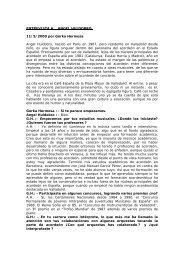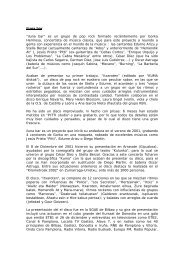The Accordion in the 19th Century - Gorka Hermosa
The Accordion in the 19th Century - Gorka Hermosa
The Accordion in the 19th Century - Gorka Hermosa
You also want an ePaper? Increase the reach of your titles
YUMPU automatically turns print PDFs into web optimized ePapers that Google loves.
FOREWORD<br />
By Prof. Dr. Helmut C. Jacobs 1<br />
<strong>Gorka</strong> <strong>Hermosa</strong>, born <strong>in</strong> 1976 Urretxu, Basque Country, is not only one of <strong>the</strong><br />
most s<strong>in</strong>gular and versatile <strong>in</strong>terpreters among <strong>the</strong> most relevant Spanish accordionists,<br />
but also a knowledgeable authority on <strong>the</strong> <strong>in</strong>ternational literature written for <strong>the</strong><br />
accordion. In his study, he has canvassed all <strong>the</strong> literature written s<strong>in</strong>ce <strong>the</strong> <strong>19th</strong> c. for<br />
<strong>the</strong> <strong>in</strong>struments that –like <strong>the</strong> accordion- have a metal free reed as a pr<strong>in</strong>ciple for <strong>the</strong>ir<br />
sound such as <strong>the</strong> physharmonica, <strong>the</strong> harmonium, <strong>the</strong> concert<strong>in</strong>a etc., whose<br />
<strong>in</strong>terpretation with <strong>the</strong> accordion is possible without h<strong>in</strong>drance and implies, enrich<strong>in</strong>g<br />
<strong>the</strong> extension of its repertoire. <strong>Gorka</strong> <strong>Hermosa</strong> completed his accordion degree at <strong>the</strong><br />
Jesús Guridi Conservatoire, Vitoria. He has received numerous awards at national and<br />
<strong>in</strong>ternational accordion contests. In 1998, he started his career as concertist and as<br />
soloist of different music ensembles, play<strong>in</strong>g s<strong>in</strong>ce <strong>the</strong>n <strong>in</strong> Spa<strong>in</strong> and o<strong>the</strong>r European<br />
countries. In his record<strong>in</strong>gs, he <strong>in</strong>troduces <strong>the</strong> accordion <strong>in</strong> unusual and extraord<strong>in</strong>ary<br />
ensembles (among o<strong>the</strong>r, with <strong>the</strong> hurdy-gurdy, <strong>the</strong> flamenco guitar, <strong>the</strong> harpsichord or<br />
<strong>the</strong> bass clar<strong>in</strong>et) and opens new stylistic paths for <strong>the</strong> <strong>in</strong>strument when he <strong>in</strong>tegrates<br />
elements from jazz, folk, pop and flamenco <strong>in</strong> his music. <strong>Gorka</strong> <strong>Hermosa</strong> displays a<br />
versatile and orig<strong>in</strong>al perception of <strong>the</strong> <strong>in</strong>strument not only <strong>in</strong> his arrangements for<br />
different <strong>in</strong>strumental ensembles, but also <strong>in</strong> his compositions for accordion solo.<br />
In his first book El Repertorio para acordeón en el Estado Español, 2003, <strong>Gorka</strong><br />
<strong>Hermosa</strong> describes, systematically and thoroughly, almost all <strong>the</strong> compositions written<br />
<strong>in</strong> Spa<strong>in</strong> for accordion solo, accordion with o<strong>the</strong>r <strong>in</strong>struments or with symphonic<br />
orchestra. In <strong>the</strong> second part of his book, he <strong>in</strong>cludes short biographies of <strong>the</strong><br />
composers. This valuable reference book is necessary for those <strong>in</strong>terested <strong>in</strong> <strong>the</strong><br />
repertoire for <strong>the</strong> accordion. Oposiciones para acordeonistas is his second book. It is a<br />
complete guide, <strong>in</strong> two volumes, enormously useful for those <strong>in</strong>terested <strong>in</strong> prepar<strong>in</strong>g<br />
entrance exams to be an accordion teacher <strong>in</strong> Spanish conservatoires. His third book El<br />
acordeón en Cantabria, describes <strong>the</strong> history of <strong>the</strong> accordion <strong>in</strong> this Spanish region,<br />
where he lives.<br />
In his fourth book, <strong>The</strong> accordion <strong>in</strong> <strong>the</strong> 19 th century, which we are now<br />
present<strong>in</strong>g, <strong>Gorka</strong> <strong>Hermosa</strong> focuses on <strong>19th</strong> c. works that were written <strong>in</strong> Europe for<br />
<strong>in</strong>struments with metal free reed. Not only are <strong>the</strong> works documented, but also <strong>the</strong><br />
diversity of <strong>the</strong> multiple types of <strong>in</strong>strument with respect to <strong>the</strong>ir structure. <strong>The</strong> first<br />
chapter deals with <strong>the</strong> predecessors of <strong>the</strong>se <strong>in</strong>struments, for example, <strong>the</strong> tcheng <strong>in</strong><br />
Asia or <strong>the</strong> guimbarde, <strong>the</strong> glass harmonica or <strong>the</strong> different types of organ <strong>in</strong> Europe. In<br />
this context, he also describes an extremely <strong>in</strong>terest<strong>in</strong>g sketch drawn by Leonardo da<br />
V<strong>in</strong>ci of a small pipe organ, with a hand-operated bellows. This organologic idea is<br />
enormously similar to <strong>the</strong> concept of <strong>the</strong> portable keyboard musical <strong>in</strong>strument, which<br />
<strong>the</strong> accordion fulfils. In <strong>the</strong> second chapter, he presents, <strong>in</strong> a very accessible way, <strong>the</strong><br />
complex organologic developments <strong>in</strong> metal free reed <strong>in</strong>struments all through <strong>the</strong> 19 th c.<br />
start<strong>in</strong>g from <strong>the</strong> accordion patented by Cyrill Demian <strong>in</strong> 1829 <strong>in</strong> Vienna. In <strong>the</strong> third<br />
chapter, he describes <strong>the</strong> music written dur<strong>in</strong>g <strong>the</strong> 19 th c. for <strong>in</strong>struments such as <strong>the</strong><br />
physharmonica, <strong>the</strong> harmonium or <strong>the</strong> concert<strong>in</strong>a and <strong>the</strong>ir <strong>in</strong>terpreters.<br />
In his book, <strong>Gorka</strong> <strong>Hermosa</strong> has succeeded <strong>in</strong> efficiently describ<strong>in</strong>g a panoramic<br />
view of <strong>the</strong> history of metal free reed <strong>in</strong>struments and <strong>the</strong>ir abundant literature,<br />
1 Helmut C. Jacobs (Bonn, 1957) is a Professor of <strong>the</strong> Romance Philology department at <strong>the</strong> University of Duisburg-Essen. His<br />
remarkable work as an accordionist and musicologist has focused on <strong>the</strong> history of free reed <strong>in</strong>struments, publish<strong>in</strong>g monographic<br />
CDs about different composers (Karg-Elert, Regondi, Beckman, Lundquist, Brehme, Jacobi, Klebe, Graham...) and books of great<br />
5




